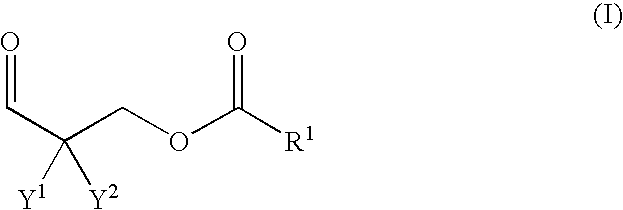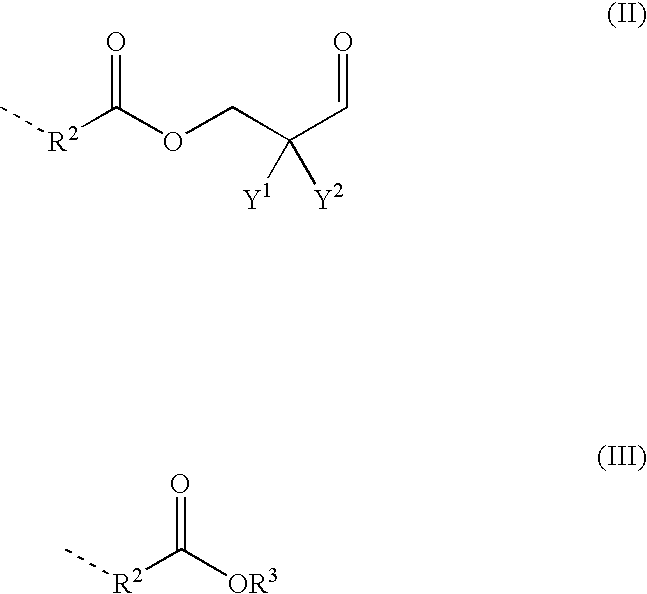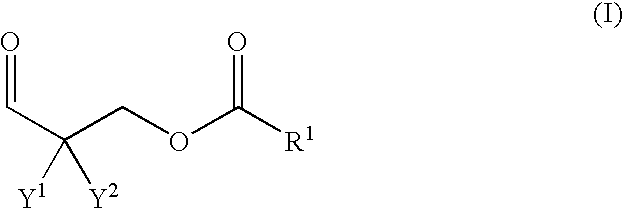Polyaldimines
a technology of polyaldehyde and aldimines, which is applied in the field of polyaldehyde, can solve the problems of headache, nausea or other health problems, and many aldehydes, and the aldimines derived from them, and achieves the effects of reducing the risk of nausea and other health problems, and reducing the and reducing the possibility of nausea and other health problems
- Summary
- Abstract
- Description
- Claims
- Application Information
AI Technical Summary
Benefits of technology
Problems solved by technology
Method used
Image
Examples
example 1 (
aldehyde A1)
[0065] A round-bottomed flask with reflux condenser, thermometer and water separator (Dean Stark) was charged with 40.5 g of formaldehyde (37% in water, methanol-free), 36.0 g of isobutyraldehyde, 100.0 g of lauric acid and 1.0 g of 4-toluenesulfonic acid and placed under a nitrogen atmosphere. The mixture was heated in an oil bath at 90° C. with vigorous stirring until the reflux rate had dropped significantly. At that point the bath temperature was raised to 120° C. and the mixture was boiled at reflux to constant temperature. Then the reflux cooling was switched off and the bath temperature was raised to 140° C., at which point water began to separate. After two hours the bath temperature was raised to 170° C. and the apparatus was evacuated under a water jet vacuum for 90 minutes. A total of around 35 ml of distillate collected in the separator. The reaction mixture was cooled to room temperature and stored under a nitrogen atmosphere. The resulting product, an odorl...
example 2 (
aldehyde A2)
[0067] As described for aldehyde A1, 42.8 g of formaldehyde (37% in water, methanol-free), 38.0 g of isobutyraldehyde, 150.0 g of stearic acid and 1.0 g of 4-toluenesulfonic acid were reacted with the separation of around 37 ml of water. The resulting product, an odorless material which was solid at room temperature with a bright orange color, was identified by mass spectroscopy as 2,2-dimethyl-3-oxopropyl stearate. Yield: 192 g.
[0068] IR: 2955, 2915, 2849, 2712 (CHO), 1732 (C═O), 1468, 1416, 1378, 1311, 1293, 1273, 1255, 1235, 1215, 1193, 1166, 1104, 1018, 988, 940, 892, 810, 777, 720.
example 3 (
aldehyde A3)
[0069] A round-bottomed flask with reflux condenser, thermometer and water separator (Dean Stark) was charged with 11.0 g of paraformaldehyde, 40.0 g of 2-methylvaleraldehyde, 64.0 g of lauric acid and 0.5 g of 4-toluenesulfonic acid and placed under a nitrogen atmosphere. The mixture was heated in an oil bath at 100° C. with vigorous stirring until the reflux rate had dropped significantly. Then the reflux cooling was switched off and the bath temperature was raised to 130° C., at which point water began to separate. After 30 minutes the bath temperature was raised to 170° C. and the apparatus was evacuated under a water jet vacuum for 90 minutes. A total of around 14 ml of distillate collected in the separator. The reaction mixture was subsequently rectified under a high vacuum. The resulting product, a colorless and odorless oil of low viscosity (boiling point 143° C. at 0.1 mbar), was identified by mass spectroscopy as 2-methyl-2-propyl-3-oxopropyl laurate. Yield: 70...
PUM
| Property | Measurement | Unit |
|---|---|---|
| thickness | aaaaa | aaaaa |
| temperature | aaaaa | aaaaa |
| temperature | aaaaa | aaaaa |
Abstract
Description
Claims
Application Information
 Login to View More
Login to View More - R&D
- Intellectual Property
- Life Sciences
- Materials
- Tech Scout
- Unparalleled Data Quality
- Higher Quality Content
- 60% Fewer Hallucinations
Browse by: Latest US Patents, China's latest patents, Technical Efficacy Thesaurus, Application Domain, Technology Topic, Popular Technical Reports.
© 2025 PatSnap. All rights reserved.Legal|Privacy policy|Modern Slavery Act Transparency Statement|Sitemap|About US| Contact US: help@patsnap.com



